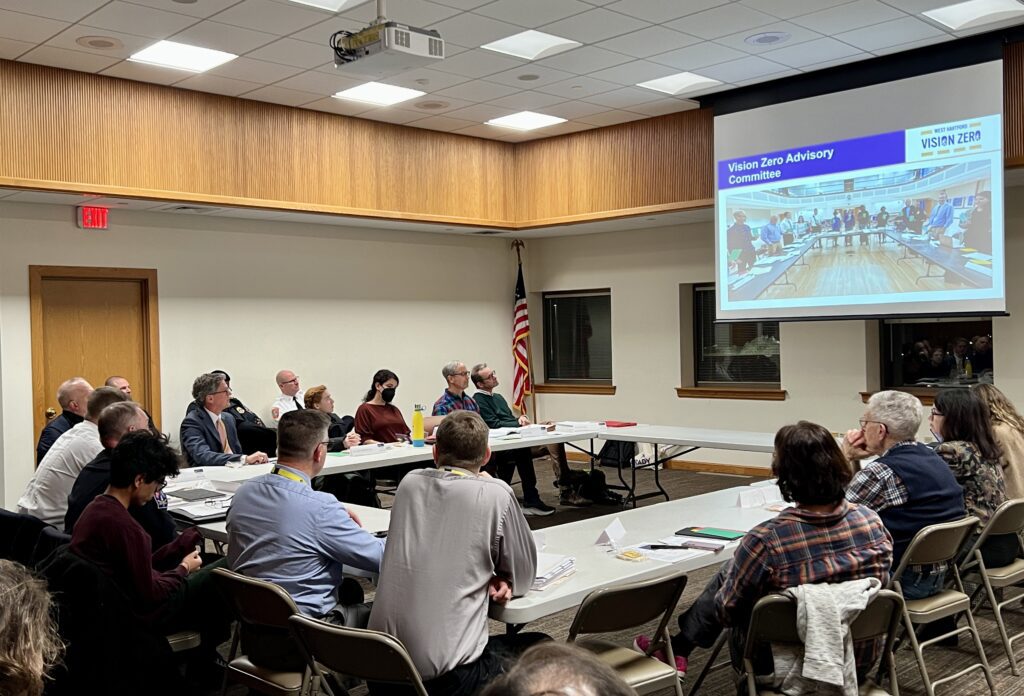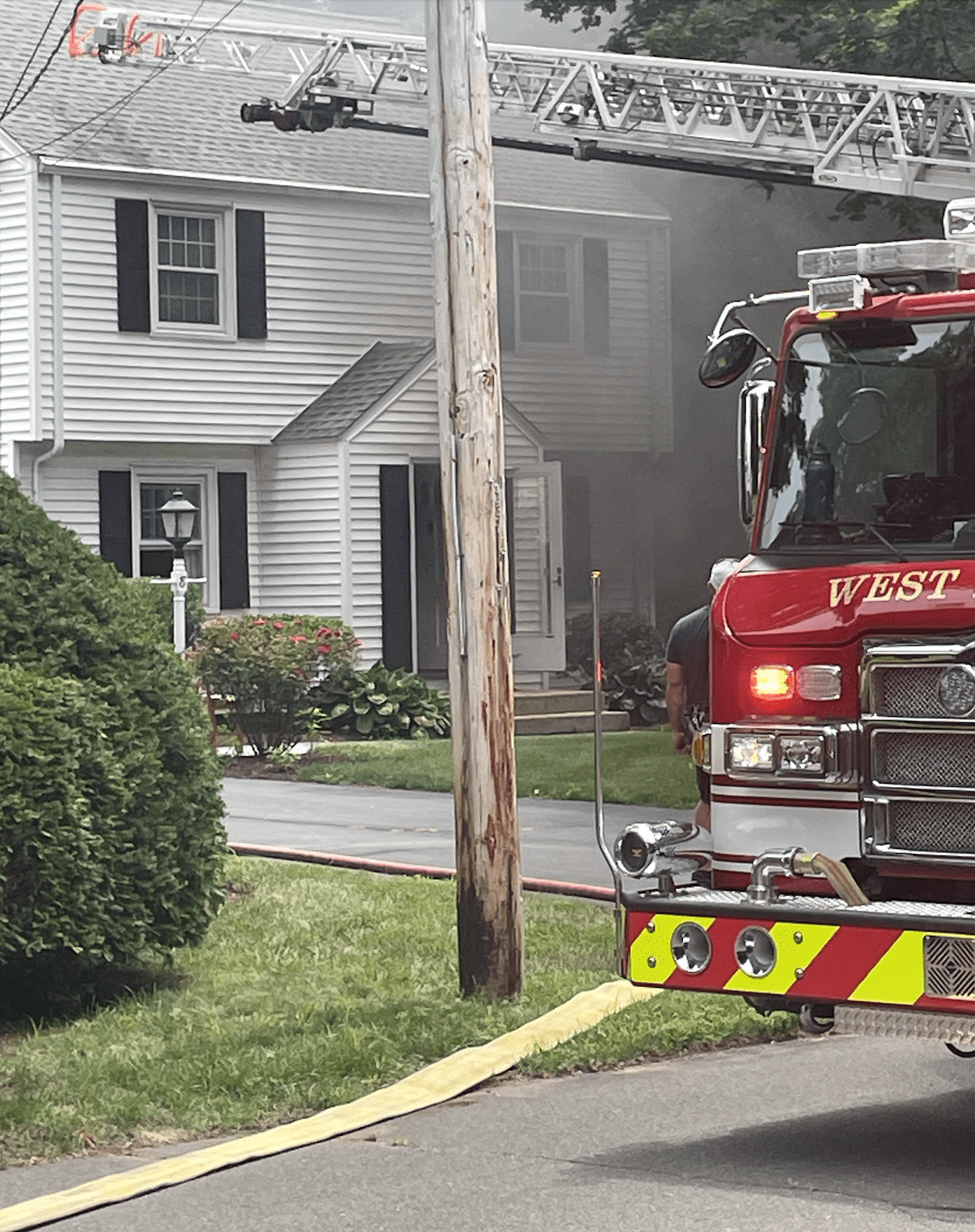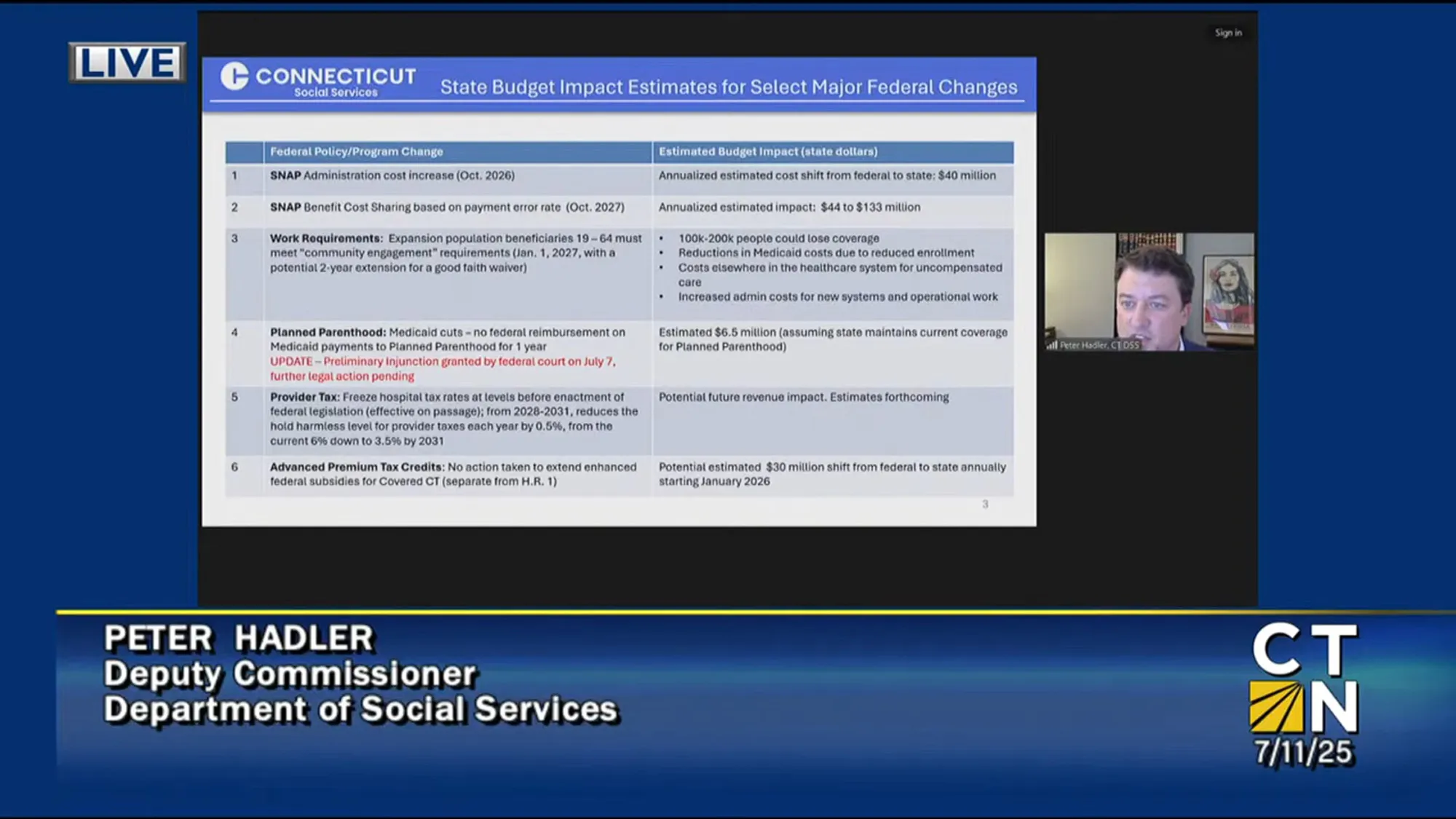West Hartford Town Council Officially Adopts Vision Zero Action Plan

Audio By Carbonatix

West Hartford Town Hall sign. Photo credit: Ronni Newton
The Town Council voted unanimously Tuesday night to adopt the Vision Zero Action Plan that has been developed over the past year and which has the goal of eliminating fatalities and serious injuries on West Hartford roadways within 10 years.
By Ronni Newton
Changes to West Hartford’s roadways, and changes to the culture of drivers, are among the components of an action plan that has been in development for just over a year – a plan which town leaders are hopeful and confident will meet the goals of “eliminating fatalities and severe injuries on West Hartford streets by 2033.”
The West Hartford Town Council on Tuesday night officially adopted the Vision Zero Plan 2024, which Town Manager Rick Ledwith said is a “significant milestone in this process.”
West Hartford is the first municipality in the state to adopt a Vision Zero Action Plan – a plan that Ledwith said “focuses on making data driven decisions, redesigning our streets for our most vulnerable users, centering equity in all of our decisions, and engaging our entire community and focusing on accountability.”
“We all remember 2022 – one of our deadliest years on our streets when we lost six lives due to traffic crashes,” he said at Tuesday night’s Council meeting, and as soon as possible thereafter, in January 2023, the process began to establish a Vision Zero Task force of 10 residents – including two high school students, one from Conard and one from Hall – and nine staff members, who worked with consultant FHI Studio and Toole Design to develop a specific plan to move forward toward the goal. The Task Force met monthly over the past year, and during the summer its subcommittees often met weekly, Ledwith said. He expressed his thanks to all for their hard work and dedication to the project.
There were also two public meetings – one last fall and one in December – and other efforts to engage the public. In particular, after the first draft of the action plan was presented in December, there were more than 50 comments from the public, feedback which was taken into account as the final plan was developed. One major suggestion was a desire to have the plan include a specific list of projects that could be undertaken immediately, before launching in-depth road safety audits, and Ledwith said, “at that point we identified a list of projects that we would complete during the first year of Vision Zero.”
That list of projects – which numbers more than 70 – will be visible immediately and the majority are related to crash response, speeding, and bicycle or pedestrian issues. A summary can be found below.
The Town Council’s Community Planning and Economic Development Committee (CPED) reviewed the draft at its January meeting, and final updates were discussed on Monday. The document, however, will not be static but rather will be a “living and breathing document” that is updated regularly “and that will be based on feedback that we receive from our community as well as things that happen traffic-wise or accident-wise through our town,” Ledwith said.
An Advisory Committee will be established and will begin its work the week of March 18, Ledwith said. Among its functions, that committee will be tasked with creating an annual report and providing quarterly updates.
“At the end of the day all that we want is for ourselves and our family and our friends to get where we are going safely,” said Tiffani McGinnis, chair of CPED, who thanked the town manager for stepping up and all involved for their hard work.
Carol Blanks, who chairs the Council’s Public Safety Committee, also thanked Ledwith for calming the town following the tragic events, and addressing concerns, and the police and fire chiefs whose collaboration has been critically important.
“There is much information in the Vision Zero report to offer as a guide to moving forward,” said Council member Barry Walters, however he added that changing habits and behavior is going to be the most difficult part of the Vision Zero initiative. “We drive fast, we drive distracted, and we drive routinely,” he said. “We must change how we drive. The number one thing that we must learn to do is slow down, be more aware of our surroundings, and stay safe.”
Walters added that he is confident that as a community we can make the changes – both physical changes to our surroundings and changes to behavior.
“We are not done but we are making progress and this has been a very long path,” said Deputy Mayor Ben Wenograd, praising the detail that is included in the Vision Zero plan. He also praised Mayor Shari Cantor’s leadership dating back to the establishment of the Complete Streets effort, and the long process it took to create the road diet on North Main Street, which has made that road much safer for all users.
“None of these things are easy. There will be a cost,” Wenograd said, in money, and in time. And, he added, slowing down traffic is a positive. “Yes, we’re going to slow down traffic and yes it may take a little bit longer to get from point A to point B in your car,” he said, but that’s going to make things safer. He also gave a shout out to the town’s Pedestrian Bike Commission and Bike West Hartford who have been “fierce advocates for change.”
“There is nothing worse … to having compromised safety for your residents,” said Cantor. Complaints that people drive too fast are a chorus she hears daily, but it’s more than just that. This could be one of the most transformational changes the town has seen.
West Hartford is the first to have an action plan, Cantor said, and the plan will position the town to obtain grants to help implement components of the plan.
“We need to commit to this but it needs to be a cultural change,” and there will be messaging and education, she said. On her way to Tuesday night’s meeting, turning onto Albany Avenue at the last minute Cantor said saw three teenage girls walking, all dressed in dark clothing. “It’s a culture change … we need to be more cautious at every turn, in a car on a bike, on your feet.”
“This all was administrative, we didn’t need to adopt this at the Council table” but voting to adopt the plan was an important statement, she added.

A draft of the Vision Zero Action Plan was reviewed with the task force at its last scheduled meeting on Jan. 8, 2024. Photo credit: Ronni Newton (we-ha.com file photo)
What’s happening right away?
Community Services Director Duane Martin previously shared with We-Ha.com the details of the projects that will be initiated in 2024
In addition to creating a crash response team and implementing the SS4A speed enforcement camera grant, accessible pedestrian signal equipment will be upgraded. There are about 60 signals on town-owned roads and more that are on state roads, but 10 – including at the intersections of South Main with Boulevard, Ellsworth, and Elmfield – will be upgraded in 2024, Martin said.
Also on the list is a review and improvement where needed of lighting at crosswalks along Albany Avenue, from Sims Road (which runs past Target, behind the Bishops Corner shopping center) to Prospect Avenue. That includes the area where this month’s pedestrian fatality occurred.
Rectangular Rapid Flashing Beacons (RRFB) signals with high intensity crosswalks will be installed at 11 locations throughout town. “These are really enhancements to make motorists aware there’s a pedestrian,” Martin said. Several areas along Boulevard (Whiting Lane, Wardwell, and Lemay), as well as crosswalks on Sedgwick Road used by those walking to Sedgwick Middle School and Duffy Elementary School are on the list.
Retroreflective pavement markings will be added to five roadway segments, including South Main Street between Park/Sedgwick and Farmington Avenue and portions of Trout Brook Drive, Farmington Avenue, and New Park Avenue. Wider edge lines will be added to eight roadway segments, including many of those slated to received retroreflective pavement markings.
The town has 10 existing speed feedback signs, and those will be relocated to areas highlighted on the High Injury Network (HIN), Martin said. Also along the HIN, sightlines at intersections will be reviewed and if necessary changes made to parking and vegetation.
A project that the town had postponed last summer while awaiting completion of the Vision Zero Action Plan and a review of the bicycle facilities – the creation of bicycle lanes on Boulevard between Mountain Road and South Main Street – is on the list of projects for implementation in 2024.
The town will be working with the Connecticut Department of Transportation to conduct a road safety audit of Albany Avenue – which is a state road – between North Main Street and Steele Road, Martin said.
The addition of dynamic no-turn-on-red signage (NTOR) “seems like a slam dunk,” Martin said, but could cause traffic issues elsewhere. These are blank signs that will illuminate when a pedestrian pushes the crosswalk button, and are very noticeable to drivers. Four locations have been identified for the installation of these dynamic NTOR signs including North Main Street at Asylum Avenue, Park Road at Trout Brook Drive, Farmington Avenue at Trout Brook Drive, and Farmington Avenue at Mountain Road.
Martin said specific locations have not been identified, but the addition of raised crosswalks will be reviewed along Boulevard and Fern Street.
Also planned is the addition of centerline rumble strips on Bloomfield Avenue (Route 189), and flashing stop signs will be installed at the intersection of Wardwell Road with Boulevard.
Various locations are slated for the addition of curve warning signage, including a stretch of South Main Street near Pebblebrook where two recent crashes in December alone have severed utility poles. Another crash took place in that same area during the most recent snowstorm.
The town will also be installing a new crosswalk on Raymond Road at Dinah Road, where pedestrians often cross from Whole Foods to Blue Back Square, Martin said.
Signage and pavement markings will be upgraded at un-signalized state road intersections such as several locations along New Britain Avenue (Route 173) in Elmwood and on North Main Street (Route 218), as well as on Albany Avenue (Route 44).
Also on the list are the installation of traffic signal backplates on roadways included on the HIN. The shields help with sun glare, and have reflective strips on them, Martin said. Martin said the use of the backplates has received a lot of positive feedback from older motorists.
For more specific details of what’s included in Vision Zero, and the process of creating the Action Plan, click here. The draft plan is also attached as a PDF below.
Like what you see here? Click here to subscribe to We-Ha’s newsletter so you’ll always be in the know about what’s happening in West Hartford! Click the blue button below to become a supporter of We-Ha.com and our efforts to continue producing quality journalism.
 Loading...
Loading...




Can we just pave our friggin roads?
[…] Feb. 27, 2024, the Town Council adopted a 10-year Vision Zero Action Plan that will guide the town in reaching its goal of eliminating fatalities and severe injuries by […]